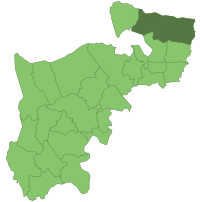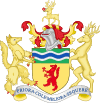Municipal Borough of Enfield facts for kids
| Enfield | |
| Motto: Priora Cole Meliora Sequere (Cherish the past but strive after even better things in the future) | |
 Enfield within Middlesex in 1961 |
|
| Geography | |
| Status | Local board (1850 - 1894) Urban district (1894 - 1955) Municipal borough (from 1955) |
| 1911 area | 12,601 acres (50.99 km2) |
| 1961 area | 12,400 acres (50 km2) |
| HQ | Little Park, Gentleman's Row 1888 - 1961 Civic Centre, Silver Street 1961 - 1965 |
| History | |
| Created | 1850 |
| Abolished | 1965 |
| Succeeded by | London Borough of Enfield |
Quick facts for kids Demography |
|
|---|---|
| 1901 population | 42,378 |
| 1961 population | 109,542 |
 |
|
Enfield was a special area in Middlesex, England. It had its own local government from 1850 until 1965. This means it had its own rules and people in charge to manage things like health and local services for the community.
Contents
What Was Enfield?
The area we now know as Enfield used to be a local government district. This district included places like Enfield Town, Brimsdown, Enfield Wash, and Ponders End. For over a hundred years, it was managed by different types of local councils. These councils helped make decisions for the people living there.
How Enfield Was Governed
Over the years, the way Enfield was governed changed a few times. It started as a small board, then became an urban district, and finally a municipal borough. Each change meant more responsibility and different ways of making decisions for the area.
Early Days: The Local Board
In 1850, the people of Enfield decided to adopt the Public Health Act 1848. This law helped communities improve public health, like making sure there was clean water and good drainage. To do this, they formed a "local board of health." This board had 12 members who were in charge of looking after the area's health and other local matters.
Becoming an Urban District
Things changed again in 1894 with a new law called the Local Government Act 1894. Enfield's local board was replaced by the Enfield Urban District. This new district was run by the Enfield Urban District Council.
The council was split into four areas called "wards." Each ward elected three councillors to represent them. These wards were Town, Chase & Bull's Cross, Ordnance, and Green Street & Ponders End. In 1909, two new wards, Bush Park and Hadley Wood & Cockfosters, were added. This meant the council grew to 18 councillors.
A Municipal Borough
In 1955, the urban district council asked for a special permission called a "charter of incorporation." This allowed Enfield to become a "municipal borough." Being a borough meant it had more power and prestige.
The new borough was run by a "corporation." This group included a mayor, who was the head of the council, ten aldermen, and thirty councillors. The borough was divided into ten wards, each electing three councillors. These wards were Bush Hill Park, Cambridge Road, Chase, Enfield Wash, Green Street, Ordnance, Ponders End, Town, West, and Willow.
The End of an Era
The Municipal Borough of Enfield didn't last forever. In 1963, the London Government Act 1963 was passed. This law changed how London was governed. On April 1, 1965, Enfield was combined with two other nearby boroughs, the Municipal Borough of Southgate and the Municipal Borough of Edmonton. Together, they formed the new and larger London Borough of Enfield that exists today.
The Meaning Behind Enfield's Coat of Arms
In 1946, the Enfield Urban District Council was given a special design called a coat of arms by the College of Arms. A coat of arms is like a unique symbol or emblem for a place or family.
- The main part of the shield showed an "enfield." This is a very rare and mythical creature in heraldry, which is the study of coats of arms. It has the head of a fox, the chest of a greyhound, the claws of an eagle, the body of a lion, and the tail of a horse.
- Above the enfield, there was a green section with silver and blue wavy lines. These lines represented the New River, which is an artificial waterway that brings water to London. The green color also stood for the Metropolitan Green Belt areas and open spaces around Enfield.
- The "crest" (the part above the shield) featured a stag, which is a male deer. This stag represented Enfield Chase, a large historic hunting ground. It also had a red rose, which is a symbol for the Duchy of Lancaster, a large estate that owned land in the area.
When Enfield became a municipal borough, it was allowed to add "supporters" to its coat of arms. These are figures that stand on either side of the shield. For Enfield, they added a stag and another enfield creature. Many of these symbols were later used in the new coat of arms of the London Borough of Enfield when it was created in 1965.

